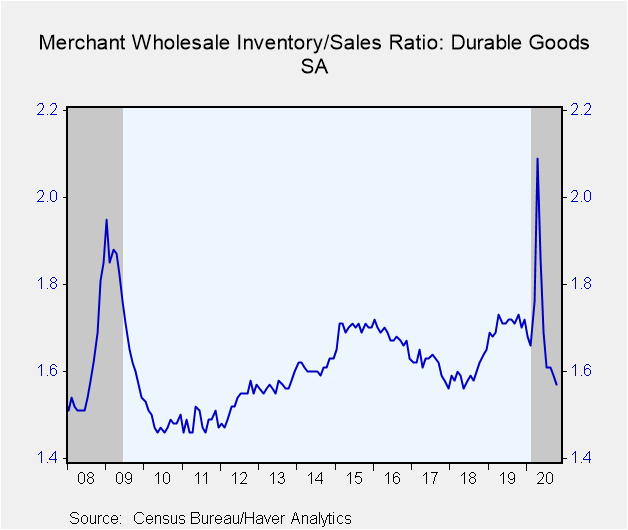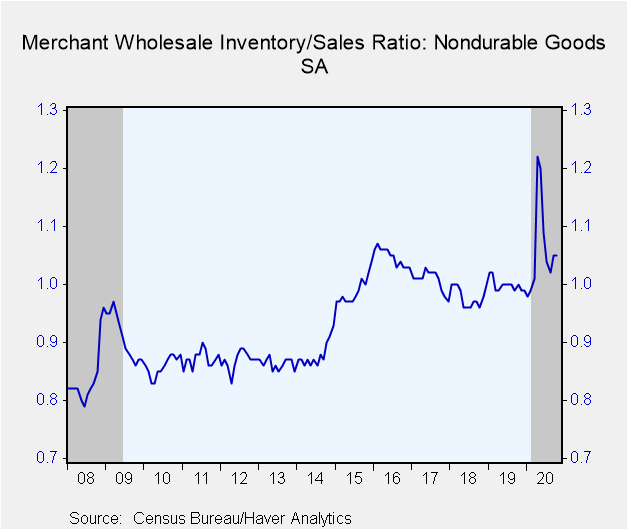 Global| Dec 09 2020
Global| Dec 09 2020Wholesale Inventories Rise Less Than Sales in October, I/S Ratio Ticks Down
Summary
• Inventories increased 1.1%, while sales jumped 1.8% in October. • Wholesale inventory-to-sales ratio edged down to 1.31. Wholesale inventories grew a greater-than-expected 1.1% in October (-2.2% year-over-year). The Informa Global [...]
• Inventories increased 1.1%, while sales jumped 1.8% in October.
• Wholesale inventory-to-sales ratio edged down to 1.31.
Wholesale inventories grew a greater-than-expected 1.1% in October (-2.2% year-over-year). The Informa Global Markets Survey anticipated a 0.9% gain. Wholesale inventory swings can have a meaningful impact on GDP. In the latest GDP report, third quarter inventory rebuild added 6.55 percentage points (ppt) to GDP; however, that was small relative to the 25.22 ppt contribution from the jump in consumption.
Durable goods inventories rose 0.3% (-5.5% y/y) with automotive, the largest, declining 0.2% (-7.1% y/y). Electrical equipment, the second largest, increased 1.0% (-2.0% y/y). Nondurables jumped 2.5% (2.9% y/y). Drug inventories, which make up over a quarter of nondurable inventories, grew 3.9% (14.5% y/y). Groceries, the second largest category, gained 0.8% (1.8% y/y).
Wholesale sales jumped up a greater-than-expected 1.8% during October (0.9% y/y). The Action Economics Forecast Survey anticipated a 0.5% rise. Durable goods sales increased 2.0% (4.1% y/y) as auto sales accelerated 5.3% (13.3% y/y). Nondurable wholesales gained 1.7% (-2.0%) as petroleum products rose 3.6% (-28.2% y/y), partly the result of a 1.5% increase in seasonally adjusted oil prices (-26.9% y/y).
The inventory-to-sales (I/S) ratio at the wholesale level ticked down to 1.31 in October from 1.32. After hitting a record 1.63 in April – data goes back to 1980 – it is back to pre-COVID-19 levels. The durable goods ratio declined to 1.57 from 1.59 the lowest in over two years. Meanwhile, the nondurable I/S ratio remains was unchanged at 1.05, down meaningfully from April's 1.22 record. The durable and nondurable series go back to 1992.
The wholesale trade figures and oil prices are available in Haver's USECON database. The expectations figure for inventories is contained in the MMSAMER database. Expectations for sales are in the AS1REPNA database.
| Wholesale Sector - NAICS Classification (%) | Oct | Sep | Aug | Oct Y/Y | 2019 | 2018 | 2017 |
|---|---|---|---|---|---|---|---|
| Inventories | 1.1 | 0.9 | 0.5 | -2.2 | 1.7 | 6.5 | 3.0 |
| Sales | 1.8 | 0.4 | 1.2 | 0.9 | 0.6 | 6.8 | 6.7 |
| I/S Ratio | 1.31 | 1.32 | 1.31 | 1.35 (Oct '19) | 1.34 | 1.28 | 1.30 |
Gerald D. Cohen
AuthorMore in Author Profile »Gerald Cohen provides strategic vision and leadership of the translational economic research and policy initiatives at the Kenan Institute of Private Enterprise.
He has worked in both the public and private sectors focusing on the intersection between financial markets and economic fundamentals. He was a Senior Economist at Haver Analytics from January 2019 to February 2021. During the Obama Administration Gerald was Deputy Assistant Secretary for Macroeconomic Analysis at the U.S. Department of Treasury where he helped formulate and evaluate the impact of policy proposals on the U.S. economy. Prior to Treasury, he co-managed a global macro fund at Ziff Brothers Investments.
Gerald holds a bachelor’s of science from the Massachusetts Institute of Technology and a Ph.D. in Economics from Harvard University and is a contributing author to 30-Second Money as well as a co-author of Political Cycles and the Macroeconomy.









